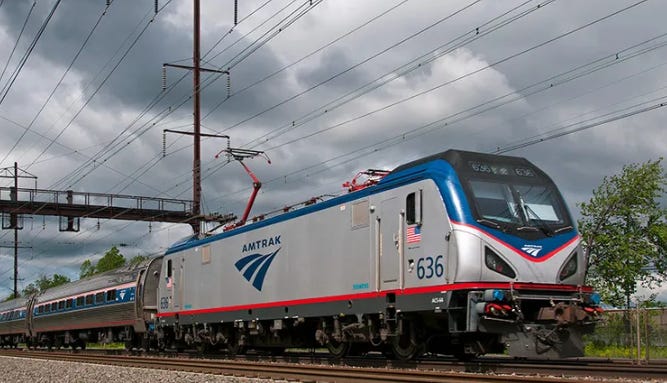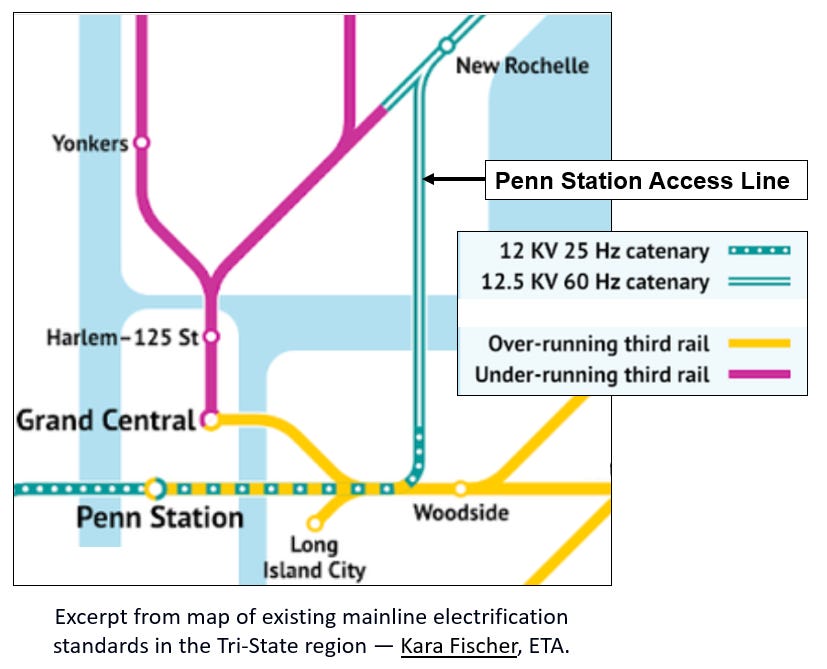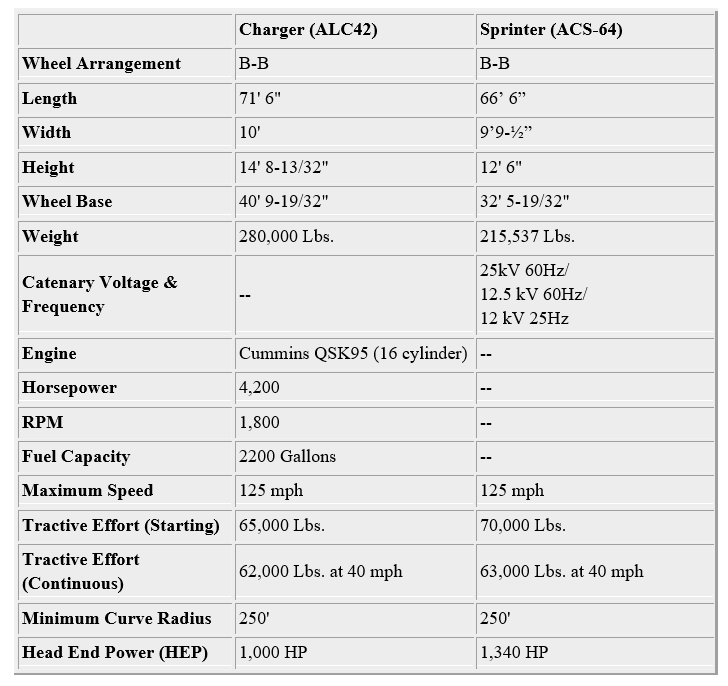Why Is the MTA Planning to Order Battery Locomotives for the Penn Station Access Line?
By John Pegram[1]
The MTA Board has approved buying 13 dual-mode, battery-electric locomotives from Siemens Mobility for use on the new Penn Station Access line, at a total cost of $304,941,000, an astonishing 25.55 million dollars each. Providing battery power—at great expense—does not make sense, because the entire line is already electrified with overhead catenaries and Amtrak operates all-electric locomotives on those tracks.
In a scathing critique of the MTA locomotive plan, the Effective Transit Alliance (ETA) has pointed out it would make much more sense to buy and use electric multiple unit railcars (EMUs), similar to the existing M8 or proposed M10 EMUs.[2]
In this article, I assume that there may be insufficient time to obtain appropriate EMUs before the Penn Station Access service opening date, but point out that the cost of Siemens ACS-64 “Sprinter” multi-mode electric locomotives, currently used on the same tracks by Amtrak, would likely be on the order of 10 - 11million dollars each.[3] Purchasing Sprinters or equivalent, standard electric locomotives would save approximately 159 - 175 million dollars as compared with the MTA battery-electric plan.
Siemens Mobility ACS-64 “Sprinter” Electric Locomotive[4]
How It Happened
On February 24th, New York Governor Kathy Hochul and the MTA issued press releases regarding the Penn Station Access plans to add new trains that will provide New Haven Line service to Penn Station and four additional stations in the Bronx. In particular, the press releases said, “In a first for North America, the passenger trains will be powered by battery- and electric-powered locomotives offering clean, green zero-emission service. The locomotives will generally draw electrical power from the overhead wires known as catenary, and switch to battery mode for tracks in and around Penn Station where electrical traction power has different characteristics.”[5]
The press releases were released two days before MTA Board approval of the locomotive plan. Typically, capital expense proposals are presented to an MTA committee by a written proposal in the month’s “Board Book” and an oral presentation. Following committee approval, the proposal is presented to the full Board for its approval.
In this case, a 1-⅓ page written proposal from the Metro-North Chief Mechanical Officer was included in the MTA February 2025 Board Book.[6] It explained that the locomotives would be purchased from Siemens Mobility as an option under an existing contract for purchase of Siemens’ SC-42 DM dual mode, diesel and third rail electric locomotives (known as the Charger series). The following paragraph was the only one discussing reasons for choice of the battery-electric (B+AC) locomotives:
The 13 B+AC locomotives will expand Metro-North’s current fleet, providing service from Penn Station to four new Bronx commuter railroad stations via Amtrak’s territory and connecting to the New Haven line through the New Rochelle station. Metro-North was provided with key operational requirements and provisions by Amtrak and CTDOT to provide service in the new Penn Station Access region. Alternative rolling stock solutions were explored. However, to meet the requirements of Amtrak and CTDOT, as well as Metro-North’s service needs, Siemens’ proposal for a B+AC locomotive presented the best solution by modifying its current Tier 4 Dual Mode diesel-electric locomotive design. After a thorough review of the current technical specifications, Siemens initiated and completed a detailed feasibility study supporting the design of the new B+AC locomotive. In maintaining the overall performance requirements, the B+AC configuration replaces the Diesel Engine with Traction Batteries as the locomotive prime mover and replaces the third-rail equipment with an AC Pantograph for operation under catenary. This also furthers Metro-North’s initiative in supporting the MTA’s mission to reduce its carbon emissions footprint with the purchase of a zero-emission locomotive fleet.
The written proposal concluded by saying, “Funding for the locomotives is available in the 2020–2024 Capital Plan.” (Note: Not the now-pending 2025-2029 plan.)
The proposal was presented near the beginning of a joint meeting of the MTA Metro-North and Long Island Railroad Committees on February 24th, and approved by vote at the end of the meeting. During the presentation, the presenter said:
We're very excited about the procurement of the B+ AC locomotives which is a clean and green rolling stock solution that will be a first for North America. The locomotives will draw electric power from the New Haven Line's overhead catenary as they operate on the New Haven line east of New Rochelle. West of New Rochelle, the locomotives are capable of operating on catenary or battery power for the 19-mile run along the Hell Gate through the Bronx and Western Queens into Penn Station.[7]
Later, at the time of voting, the presenter told the committee:
Alternate rolling stock solutions were explored, however, to meet the requirements of Amtrak and the Connecticut Department of Transportation, as well as Metro North service needs, Siemens’ proposal presented the best solution. These locomotives will ensure reliable passenger service with a zero-emission locomotive fleet.[8]
The next day, the battery-electric locomotive proposal was briefly mentioned and later approved in a meeting of the full Board on February 26th.[9]
Neither the written proposal, nor the committee or full Board discussions, explained the “Alternative rolling stock solutions,” which the written proposal said “were explored.” No one questioned the cost or why battery power was required on the already electrified Penn Station Access line. No explanation was provided for having the MTA pay Siemens to modify the Charger design by removing the diesel engine, generator, fuel tanks and third rail pickup, and adding a battery system and pantograph, when standard locomotives of the same type used by Amtrak on the same tracks—such as the Siemens Sprinter—could be used.
The Penn Station Access Electric Power Issue
Modern electric locomotives and EMUs collect power in one form from an overhead catenary or third rail, and then convert that power to another form considered most suitable for operation of the locomotive’s electric motors. Because conversion is required in any case, it is relatively simple to build a multi-mode locomotive or EMU that can use more than one type of electric power.
As summarized in the map below, four different types of electric power supply are used for the New York City commuter rail lines. The Long Island Railroad uses a direct current (DC) third rail, which is arranged so that the power collecting “shoe” on the locomotive or EMU runs on the top of the third rail (over-running). Metro North uses similar DC power, but with the third rail arranged for the shoe to run under the third rail (under-running).
Multi-mode locomotives and EMUs are common in the New York City area. For example, the Metro-North New Haven line trains obtain power from a third rail between Grand Central Station and near to East Mount Vernon, NY, and an overhead catenary east of there. That catenary supplies 12.5 thousand volt (KV) alternating current (AC) power at 60 Hertz (cycles-per-second). Amtrak trains running between Connecticut and New Jersey through Penn Station obtain their power from catenaries. North and east of Queens, NY, the catenary power is 12.5 KV at 60 Hertz, while south and west of there, the power is 12 KV at 25 Hertz. Amtrak locomotives, such as the Siemens ACS-64 “Sprinter” depicted at the beginning of this article, have no difficulty in working with either type of power.[10]
Siemens Mobility appears to offer two principal lines of locomotives in the United States, the diesel engine powered Charger series and the electrically powered Sprinter series.[11] Some of their comparative specifications are listed below:
This comparison does not suggest any relevant superiority of a dual mode electric locomotive based on the Charger over the standard Sprinter for the Penn Station Access line.
Why Was This Choice Made?
We do not have sufficient information to understand why MTA management decided that buying 13 dual-mode, battery-electric locomotives for use on the Penn Station Access line is the best choice among alternatives. We can only make informed guesses based on clues in the available information referenced above.
The written proposal mentions consideration of “the requirements of Amtrak and CTDOT, as well as Metro-North’s service needs.” It is hard to imagine that either Amtrak or Metro-North would not accept use of the same Sprinter-type locomotives as are currently used on the same tracks by Amtrak. Could the use of batteries have been influenced by the Connecticut Department of Transportation (CTDOT)? Perhaps, because the Danbury and Waterbury branches in Connecticut are not electrified, and currently served by trains with diesel locomotives. But, as the ETA critique points out, catenary electric power would be a much better solution for those branches, and could be provided at a cost of 150 million dollars. That is around the same amount as the 154 - 175 million dollar premium that the MTA would pay for 13 battery-electric locomotives. (The ETA also suggests that 13 locomotives would be an insufficient number for the proposed Penn Station Access service).[12]
Two other factors potentially affecting the choice of battery-electric locomotives are (1) funding is expected to come from the 2020-2024 Capital Plan, not the currently-proposed 2025-2029 Capital Plan, and (2) Metro-North proposes to purchase those locomotives by a modified option under an existing contract with Siemens Mobility for purchase of dual mode diesel-third rail Charger locomotives. That contract is funded by the Federal Transit Authority (“FTA”). Could it be that the proposed modification of the Charger design is an attempted end-run around limitations in the 2020-2024 Capital Plan or the Siemens Mobility contract or the FTA funding agreement? If so, that is an unreasonably expensive end-run.
Would it not be possible to simply purchase standard Sprinter locomotives for 10-11 million dollars, for example, by a modified option under the existing contract? Or would a decision to buy a dual mode all-electric locomotive force a new and time-consuming bidding procedure, or a new FTA funding approval?
Because of the huge cost premium for providing a battery power mode in the new locomotives, MTA management should provide a full explanation to the MTA Board and the public. Probably, the current plan should be withdrawn and Sprinter locomotives purchased instead.
This article expresses the personal views of the author and does not express the views of his employer, or any client or organization. The author has degrees in law and physics, and has taken several engineering courses. After five years of work as an engineer, he has practiced law primarily in the field of patents for over 50 years, dealing with a wide variety of technologies. He is a life-long railfan and user of public transportation in the United States, Europe and Japan.
As usual a PDF copy of this article is attached.
[1] © John Pegram, 2025.
[2] https://www.etany.org/baffling-battery-blunder.
[3] Amtrak ordered 70 ACS-64 “Sprinter” locomotives from Siemens Mobility in 2010 at a cost of 6.66 million dollars each. See https://assets.new.siemens.com/siemens/assets/api/uuid: 706784c8-348a-49da-9415-321604cd319a/IC201402008e.pdf. With inflation to 2025, that cost would be 9.72
million dollars each.
In 2015, SEPTA contracted to buy 18 (including options) ACS-64 “Sprinter” locomotives from Siemens Mobility at a cost of 8.56 million dollars each. See https://web.archive.org/web/20171207142951/http://www.phillymag.com/ news/2015/11/11/septa-locomotives/. With inflation to 2025, that cost would be 11.64 million dollars each.
[4] Photo from Siemens Mobility website at https://www.mobility.siemens.com/us/en/portfolio/rolling-stock/locomotives.html.
[5] https://www.mta.info/press-release/icymi-governor-hochul-announces-metro-north-operate-first-nation-battery-and-electric; https://www.governor.ny.gov/news/governor-hochul-announces-metro-north-operate-first-nation-battery-and-electric-powered
[6] Attached.
[7] https://www.youtube.com/live/l6JKwpfvg4g at 21:06,.
[8] Id. at 1:28:45.
[9] https://www.youtube.com/live/QqWQcOATBa8 at 1:50:56.
[10] Locomotives and EMUs designed to receive power at 25 Hertz require a larger transformer to reduce the voltage from the catenary than those designed only for 60 Hertz operation. Typically, those designed for 25 Hertz operation can use either 25 or 60 Hertz power.
[11] https://www.mobility.siemens.com/us/en/portfolio/rolling-stock/locomotives.html.
[12] See note 2 above.



